Study guides, Class notes & Summaries
Looking for the best study guides, study notes and summaries about ? On this page you'll find 50 study documents about .
All 50 results
Sort by
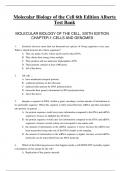
-
Complete Test Bank Molecular Biology of the Cell 6th Edition Alberts Questions & Answers with rationales (Chapter 1-24)
- Exam (elaborations) • 645 pages • 2023
-
- $16.99
- 33x sold
- + learn more
Molecular Biology of the Cell 6th Edition Alberts Test Bank Complete Test Bank Molecular Biology of the Cell 6th Edition Alberts Questions & Answers with rationales (Chapter 1-24) PDF File All Pages All Chapters Grade A+
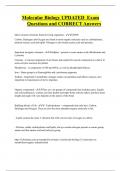
-
Molecular Biology UPDATED Exam Questions and CORRECT Answers
- Exam (elaborations) • 19 pages • 2024
-
- $8.99
- + learn more
Most common elements found in living organisms - CHON Carbon, Hydrogen and Oxygen are found in most organic molecule such as carbohydrates, proteins nucleic acid and lipids. Nitrogen is also found nucleic acid and proteins. Important inorganic elements - Sulphur - present in some amino acids (Methionine and Cysteine) Calcium - A crucial component of our bones and needed for muscle contraction (co-factor in some enzyme reactions for plants) Phosphorus - A component of ATP and DNA, as we...
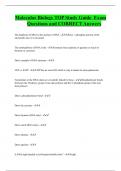
-
Molecular Biology TOP Study Guide Exam Questions and CORRECT Answers
- Exam (elaborations) • 10 pages • 2024
-
- $8.49
- + learn more
The backbone of DNA is this portion of DNA - ribose + phosphate portion of the nucleotide since it is invariant The nonbackbone of DNA is the - aromatic base (adenine or guanine or uracil or thymine or cytosine) Draw example of DNA structure - ATP vs. dATP - ATP has an extra OH which is why d stands for deoxyadenosine Nucleotides in the DNA chain are covalently linked by these - phosphodiester bonds (between the 3'hydroxy group of one deoxyribose and the 5' phosphate group of the ne...
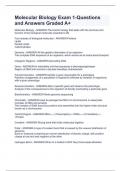
-
Molecular Biology Exam 1-Questions and Answers Graded A+
- Exam (elaborations) • 80 pages • 2024
-
Available in package deal
-
- $10.39
- + learn more
Molecular Biology Exam 1-Questions and Answers Graded A+ Molecular Biology - ANSWER-The branch biology that deals with the structure and function of the biological molecules essential to life Four classes of biological molecules - ANSWER-Proteins Lipids Nucleic Acids Carbohydrates Genome - ANSWER-All the genetic information of an organism The complete DNA sequence of an organism, which serves as its instructional blueprint Intergenic Regions - ANSWER-Noncoding DNA Gene - ANSWER-...
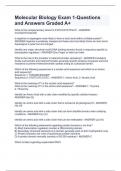
-
Molecular Biology Exam 1-Questions and Answers Graded A+
- Exam (elaborations) • 30 pages • 2024
-
Available in package deal
-
- $10.49
- + learn more
Molecular Biology Exam 1-Questions and Answers Graded A+ What is the complementary strand to 5'GTCCATATTGC3' - ANSWER-3'CAGGTATAACG5' Is arginine or asparagine more likely to form a ionic bond within a folded protein? - ANSWER-Arginine is positively charged and basic and most likely forms an ionic bond. Asparagine is polar but not charged. Identify one major structural motif (DNA binding domain) found in sequence specific to transcription regulators - ANSWER-Zinc Finger or helix turn ...
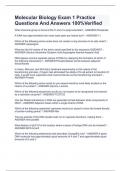
-
Molecular Biology Exam 1 Practice Questions And Answers 100%Verified
- Exam (elaborations) • 5 pages • 2024
-
Available in package deal
-
- $7.99
- + learn more
Molecular Biology Exam 1 Practice Questions And Answers 100%Verified What chemical group is found at the 5' end of a polynucleotide? - ANSWER-Phosphate A-DNA has approximately how many base pairs per helical turn? - ANSWER-11 Which of the following amino acids does not contain a ring structure in its side chain? - ANSWER-Asparagine What are the full names of the amino acids specified by the sequence GQENAD? - ANSWER-Glycine-Glutamine-Glutamic Acid-Asparagine-Alanine-Aspartic Acid ...
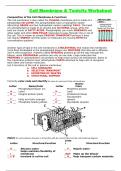
-
Cell Membrane & Tonicity Worksheet
- Exam (elaborations) • 9 pages • 2024
-
- $12.49
- + learn more
In a molecular and cell biology course, students delve into the intricate workings of cells and the molecules that comprise them. Here's an overview of what's typically covered: Cell Structure and Function: Students learn about the structure and function of cells, including organelles such as the nucleus, mitochondria, endoplasmic reticulum, Golgi apparatus, and chloroplasts (in plant cells). They explore how these organelles work together to carry out essential cellular processes such as m...
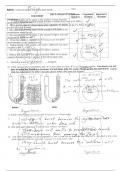
-
BIOLOGY PRACTICE TEST FOR OSMOSIS COMPLETELY SOLVED
- Exam (elaborations) • 1 pages • 2024
-
- $17.99
- + learn more
In a molecular and cell biology course, students delve into the intricate workings of cells and the molecules that comprise them. Here's an overview of what's typically covered: Cell Structure and Function: Students learn about the structure and function of cells, including organelles such as the nucleus, mitochondria, endoplasmic reticulum, Golgi apparatus, and chloroplasts (in plant cells). They explore how these organelles work together to carry out essential cellular processes such as m...
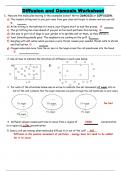
-
Diffusion and Osmosis Worksheet
- Exam (elaborations) • 2 pages • 2024
-
- $15.99
- + learn more
In a molecular and cell biology course, students delve into the intricate workings of cells and the molecules that comprise them. Here's an overview of what's typically covered: Cell Structure and Function: Students learn about the structure and function of cells, including organelles such as the nucleus, mitochondria, endoplasmic reticulum, Golgi apparatus, and chloroplasts (in plant cells). They explore how these organelles work together to carry out essential cellular processes such as m...
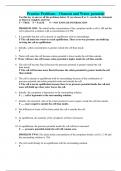
-
Practice Problems – Osmosis and Water potential
- Exam (elaborations) • 3 pages • 2024
-
- $15.49
- + learn more
In a molecular and cell biology course, students delve into the intricate workings of cells and the molecules that comprise them. Here's an overview of what's typically covered: Cell Structure and Function: Students learn about the structure and function of cells, including organelles such as the nucleus, mitochondria, endoplasmic reticulum, Golgi apparatus, and chloroplasts (in plant cells). They explore how these organelles work together to carry out essential cellular processes such as m...

-
INTRODUCTION TO MOLECULAR AND CELL BIOLOGY CHAPTER 8. MEMBRANE TRANSPORT
- Exam (elaborations) • 35 pages • 2024
-
- $10.99
- + learn more
In a molecular and cell biology course, students delve into the intricate workings of cells and the molecules that comprise them. Here's an overview of what's typically covered: Cell Structure and Function: Students learn about the structure and function of cells, including organelles such as the nucleus, mitochondria, endoplasmic reticulum, Golgi apparatus, and chloroplasts (in plant cells). They explore how these organelles work together to carry out essential cellular processes such as m...

That summary you just bought made someone very happy. Also get paid weekly? Sell your study resources on Stuvia! Discover all about earning on Stuvia


